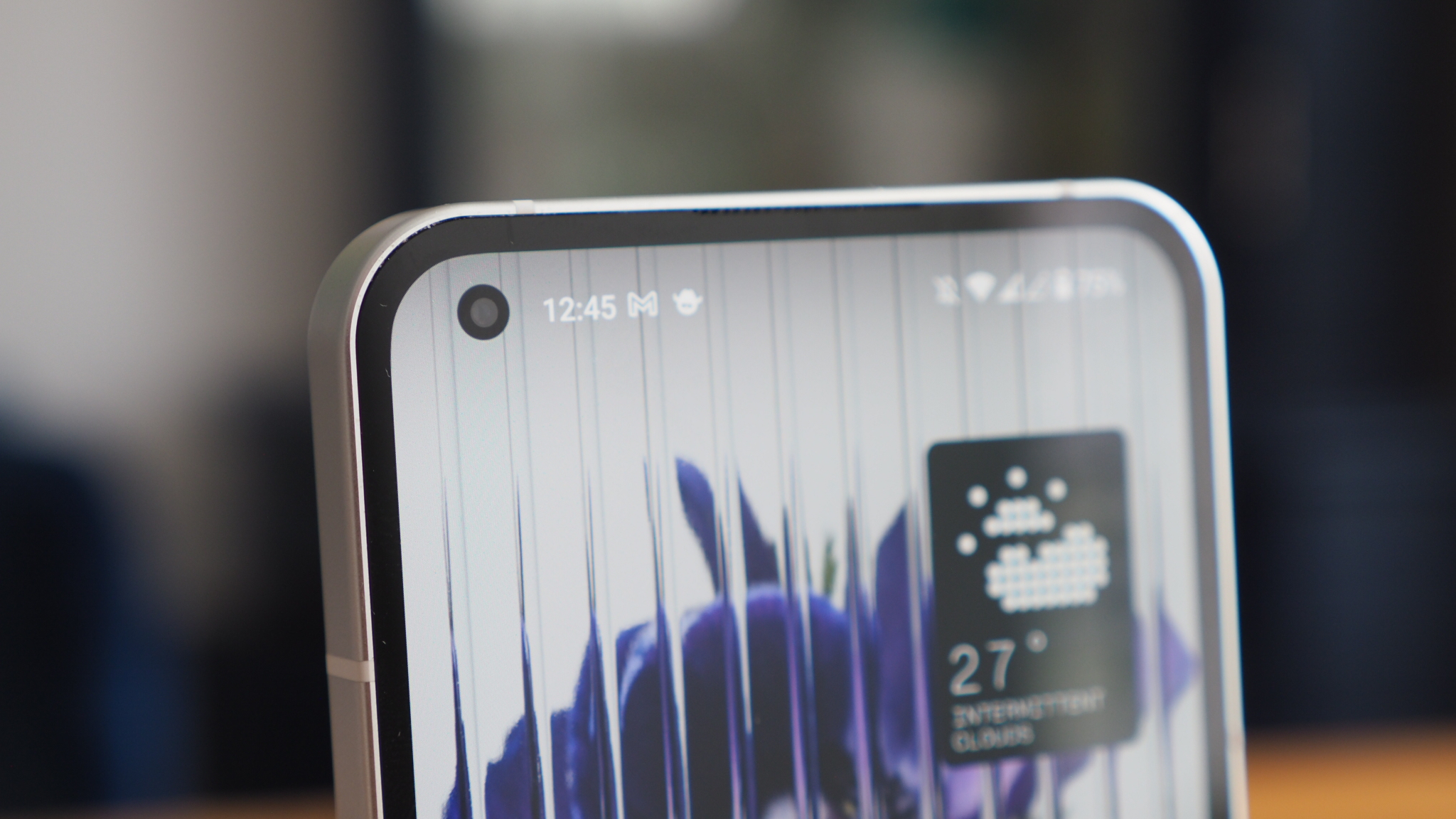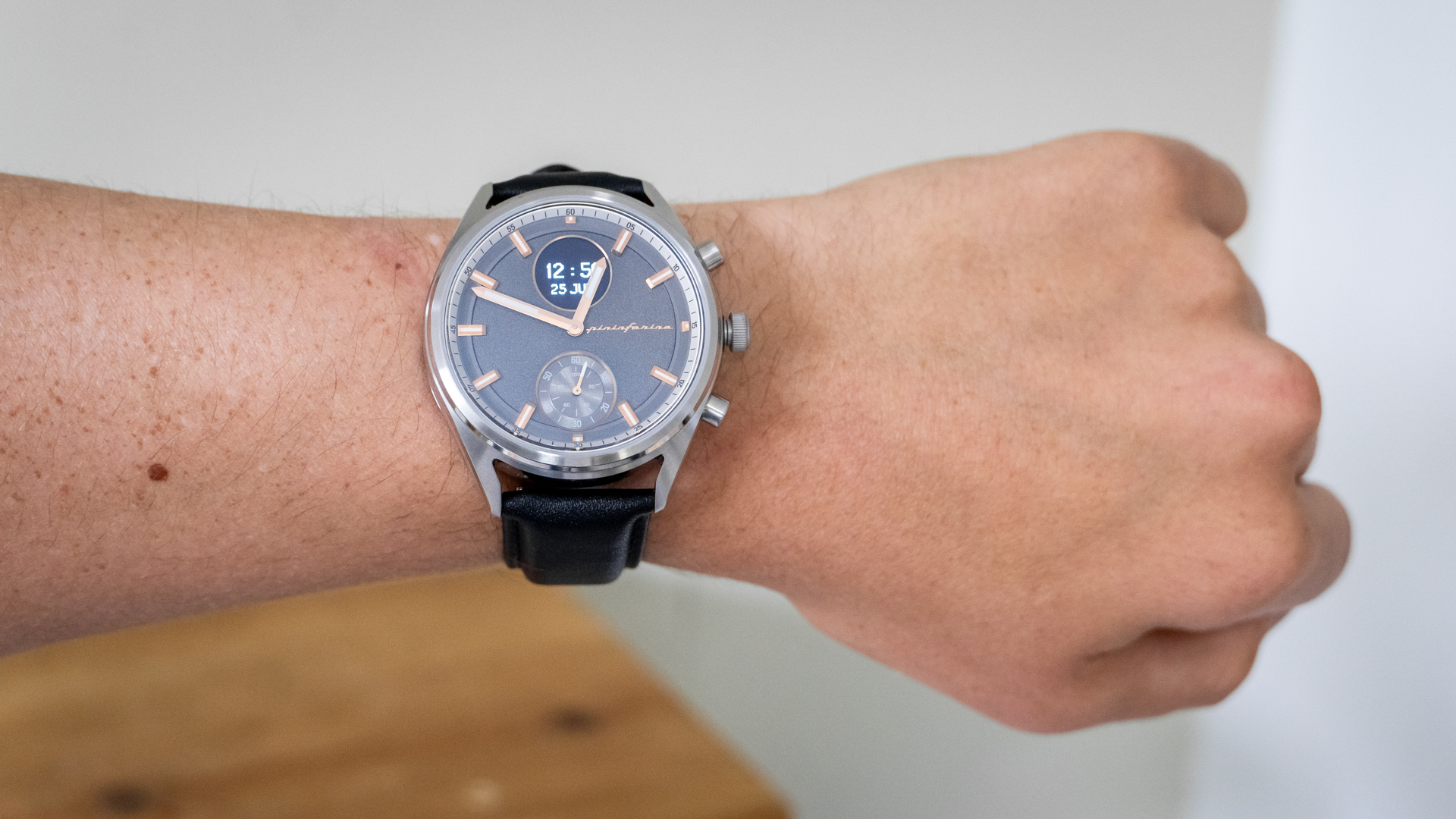

Legendary Italian design house Pininfarina burst onto the smartphone scene in 2023 with the Senso Hybrid. Being a certified petrolhead and a huge fan of Ferrari sports cars – which Pininfarina designed for decades – I was excited to see the results.
The Senso Hybrid was beautifully designed but let down by a smartphone app that felt buggy and unfinished. Have things improved with the new Sintesi? Read on to find out.
Pininfarina Sintesi Hybrid: Design and features
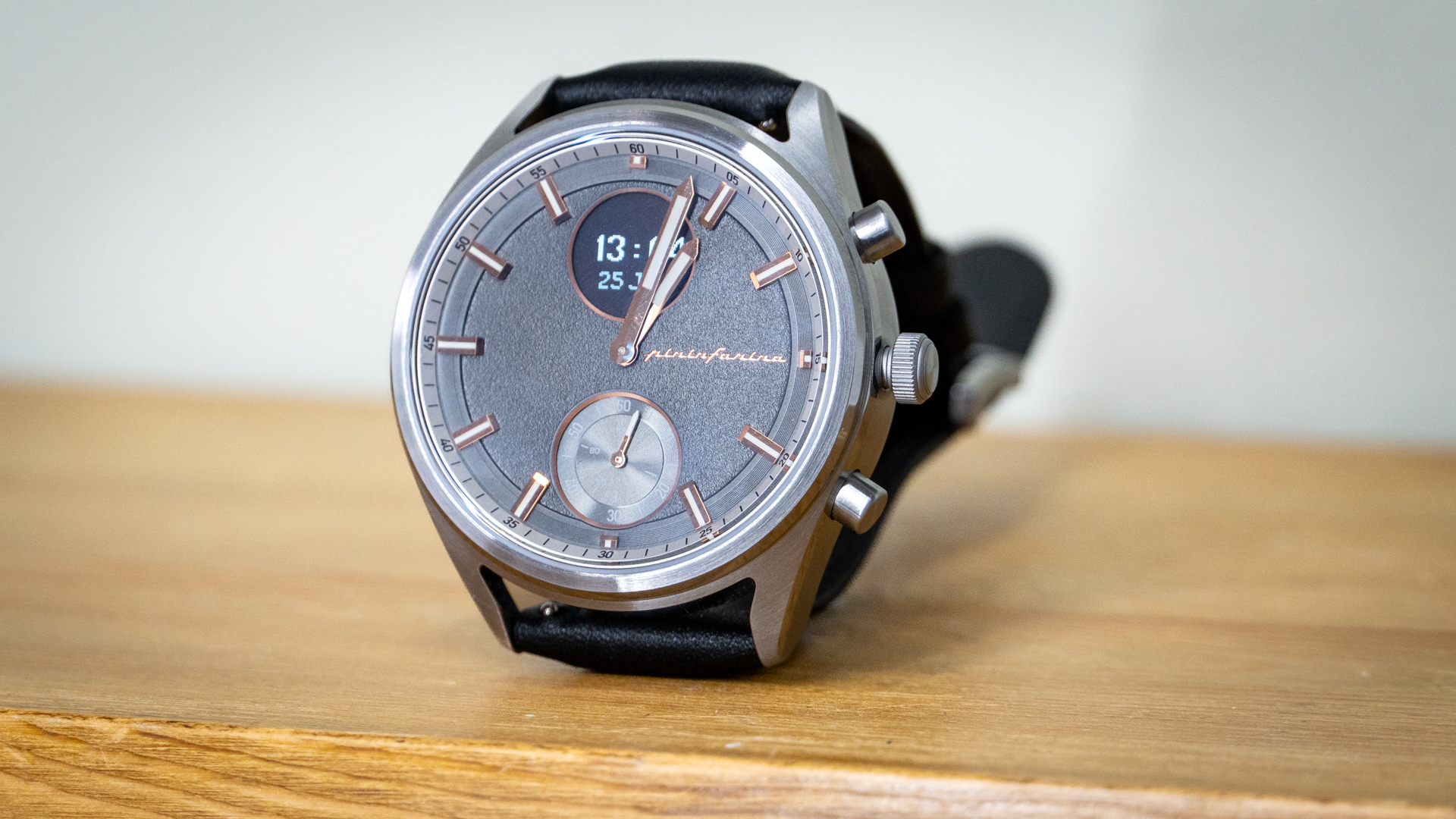
First impressions are just as good as they were with the Senso. Pininfarina’s new hybrid watch is beautiful, with a stainless steel case, leather strap and sapphire crystal – all the things you’d expect from a £379 timepiece.
For me, the case isn’t quite as distinctive as the beautiful cushion-like design of the Senso, but it still packs a visual punch thanks to the textured grey dial (reminding me of the dashboard of a ‘60s Ferrari) and the bronze detailing of this particular model. The watch is also available in black with white hour markers, blue with a matching blue strap, and cream with a sand-coloured strap.
All four variants have the same basic layout, which includes a small AMOLED display at the 12 o’clock position. This shows basics like the date and digital time, along with a simple menu system that is navigated by rotating and pressing the crown and buttons on the side of the case. The lower button acts as a shortcut key, taking you straight to whichever type of exercise you do most frequently. Set that up, and it’s one press of that button, then a press of the crown, and the watch starts recording that exercise type – handy when you’ve just jumped onto a treadmill or about to set off on your bike.

Like the Senso, the new Sintesi has an analogue sub-dial at the six o’clock position. This is used to show what percentage of your daily activity goal you have completed, and adds a nice dose of traditional watch design to the face.
At 44 mm, the case is the same size as that of the Senso – and boy, can you feel it. This is a big watch by today’s standards, and is larger even than some of the best smartwatches. I prefer smaller watches, with case diameters under 40 mm being the ideal, so for me it’s simply too big to be worn every day, and I certainly wouldn’t wear it at night to make use of its sleep-tracking function. This is purely subjective though, and lovers of larger watches will have plenty of reasons to like the Pininfarina too.
Sign up to the T3 newsletter for smarter living straight to your inbox
Get all the latest news, reviews, deals and buying guides on gorgeous tech, home and active products from the T3 experts
Just a few years ago, it was perfectly acceptable for smartwatches and hybrids to be this large. But improvements in battery technology and processor efficiency have led to slimmer, smaller devices. The Apple Watch Series 9 is significantly more compact in every dimension than the Pininfarina, and so too are hybrids like the Withings Scanwatch 2. I appreciate that some people like bigger watches, but I still hope Pininfarina will bring out a smaller hybrid soon.
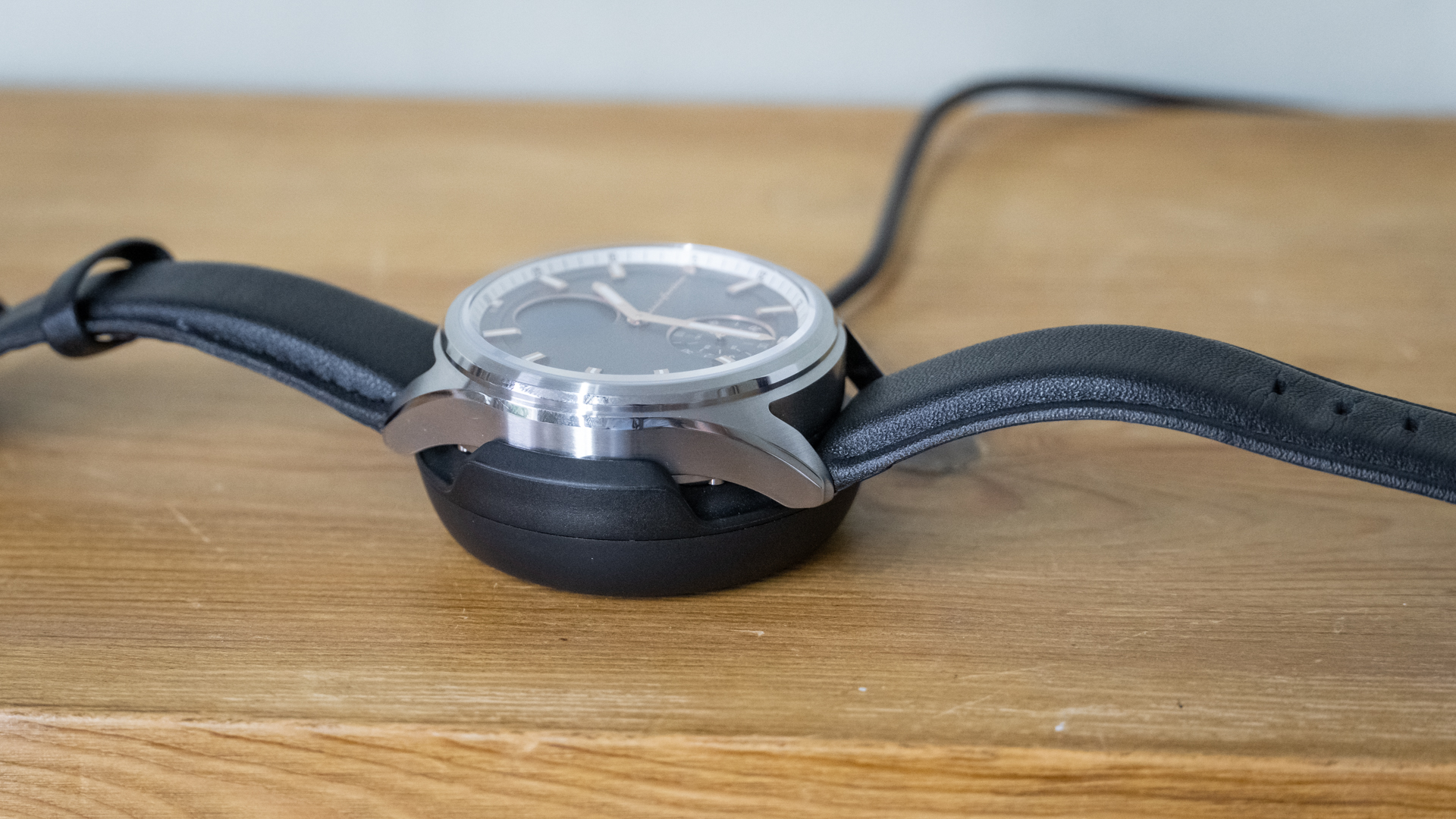
In better news, I like how the dial is protected by a scratch-resistant sapphire crystal – something the aluminium version of Apple Watch Series 9 misses out on – and the Sintesi’s 50 metres of water resistance is welcome, since that makes it safe to swim with. The use of quick-release lug bars is also welcome, making it easy to swap out the strap without tools.
Lastly, the watch is charged by placing it on the included dock, which then draws power from a USB-C connection – just make sure you don’t lose the dock, as it uses a bespoke pin-style connection to attach to the watch.
What’s the Pininfarina Sintesi Hybrid like as a smartwatch?
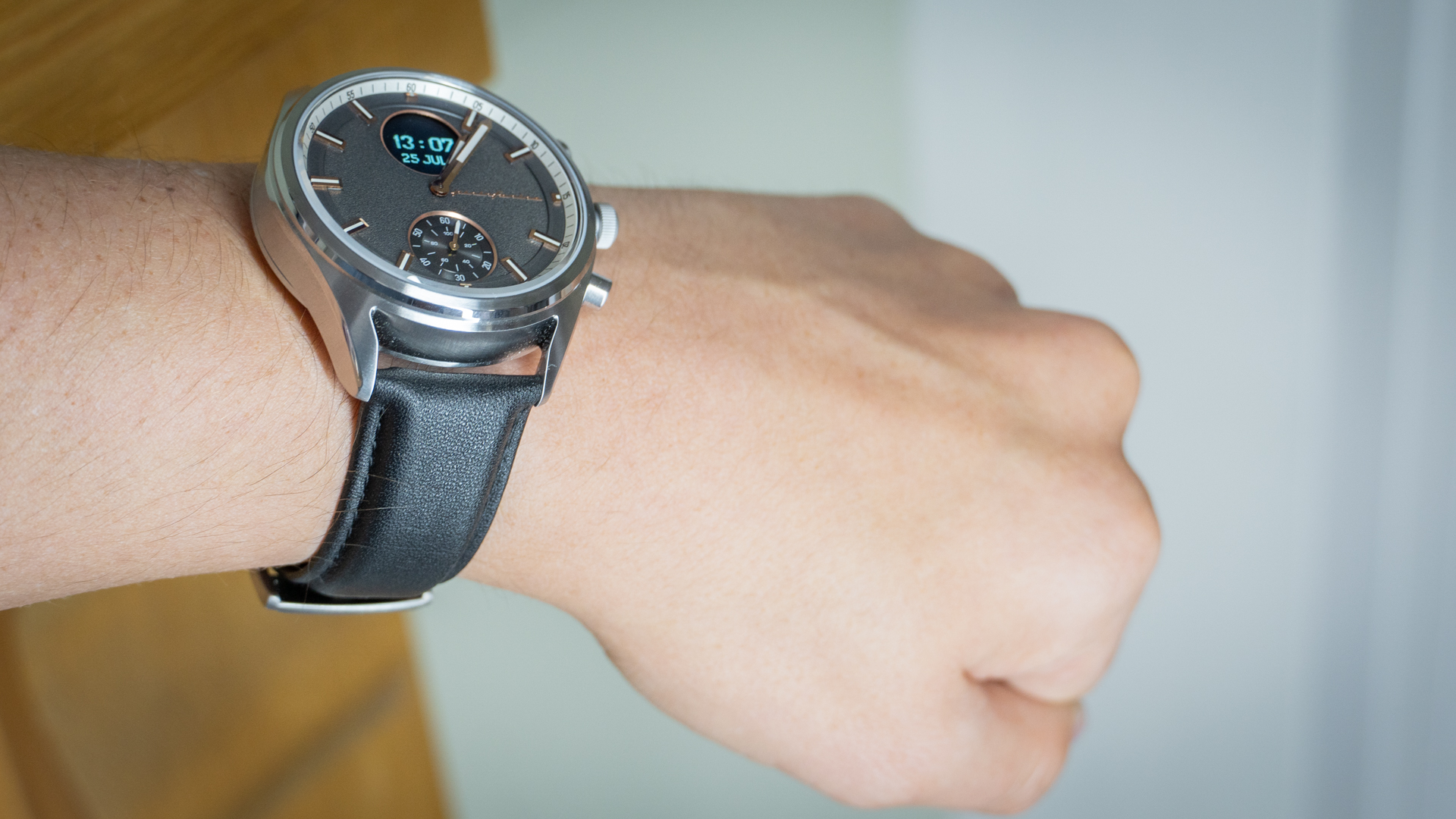
I’m pleased to report that the software problems I encountered with the Senso have largely been fixed for the new Sintesi. The app (free for iOS and Android) still isn’t a match for those from Apple or Withings, but it’s an improvement nonetheless and acts as a perfectly decent place to adjust settings and check in on your daily activity, exercise and sleep.
There are still some quirks to be ironed out – like how the Pininfarina app talks about an ECG function in the heat health section, but goes on to say that capability is missing from his watch (it’s only on the slightly more expensive Senso).
Also frustrating is how the app does not work properly when your phone has no internet connection, and how text often feels like it has been crudely translated rather than being the work of a native copywriter. An example is how the Active Minutes section of the weekly highlight states: “Stay active, stay young. Cheer up!”
The calories section shouts: “Get started, don’t quit!” without any context on what I’m supposed to be starting, or indeed quitting. As with the Senso, it’s down to Globics, the technology company that designed, manufactures and distributes Pininfarina’s smartwatches, to up their game and offer a software experience that lives up to the hardware and the price tag.
Data collected by the Sintesi can thankfully be sent straight to Apple Health, Google Fit or Strava, so you can just use those apps instead. As well as movement, exercise and sleep, the watch tracks your heart rate, provides an SpO2 (blood oxygen) measurement and logs BMI, weight and calories. There’s also a tool in the app for (manually) keeping tabs on your daily water intake too. There’s disappointingly no integrated GPS, but the watch can use your phone’s for logging outdoor runs.
The rest of the watch works largely as you’d expect from a hybrid. Notifications are delivered to your wrist with a subtle vibration, there are stopwatch, alarm and timer functions accessible through the watch’s own interface, and you can see a basic weather forecast (temperature highs and lows) for the next few days at a glance. There’s a compass too, which shows your heading on the digital screen and uses the hands to point north. As ever with hybrids, I prefer to limit notifications to the bare essentials, like calls and text messages.
Pininfarina doesn’t state a battery life for the Sintesi, but the “up to 14 days of typical use” of the Senso feels about right. As ever with smartwatches, this will depend greatly on how you use the device.
Should you buy the Pininfarina Sintesi Hybrid?
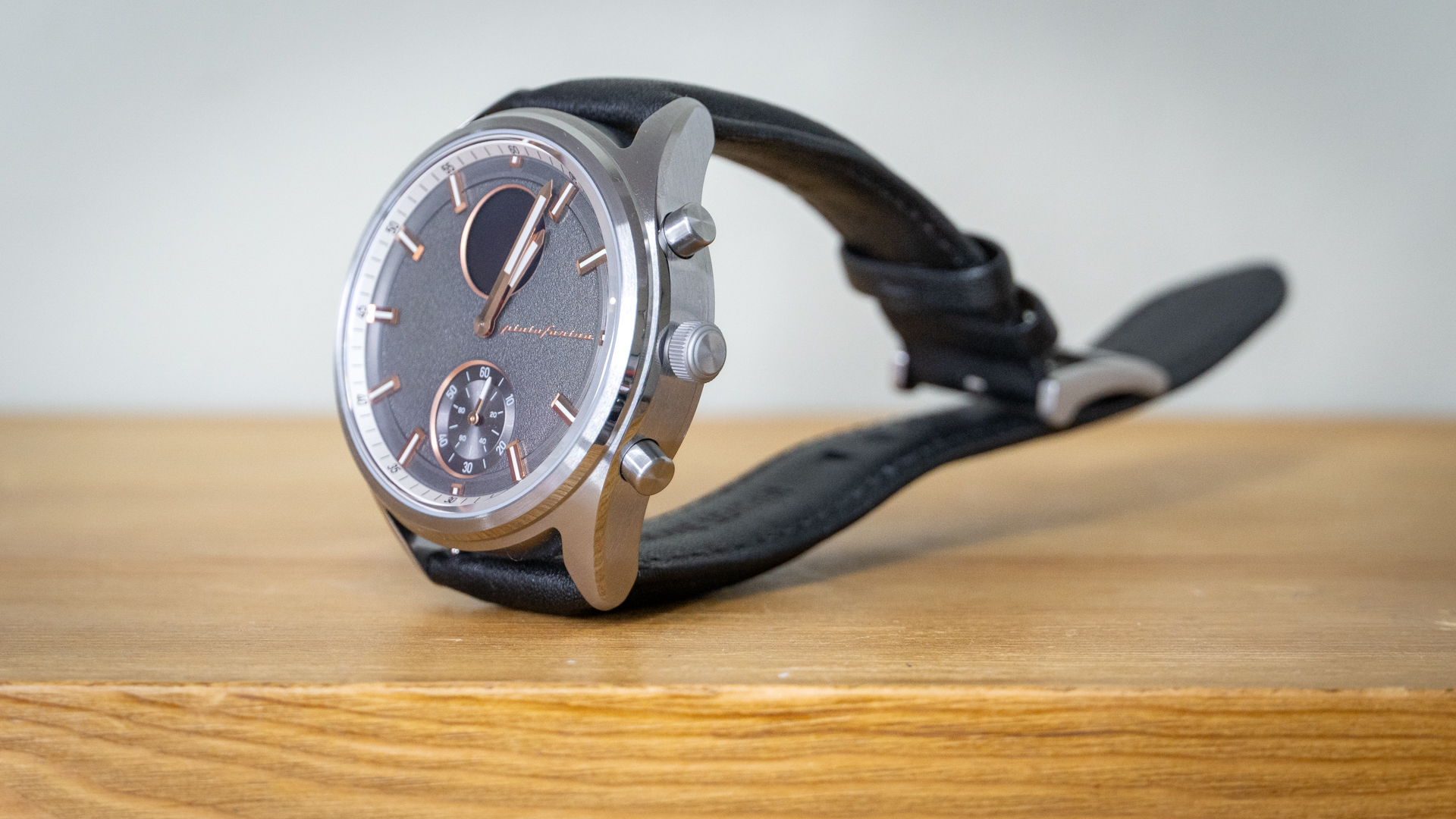
The Pininfarina name carries a lot of weight among petrolheads and design buffs, and in some cases that alone will be enough to make a sale. I personally prefer the more distinctive look of the Senso, but still appreciate the new Sintesi, especially in blue with the matching strap.
There’s no escaping the size, but if you’re happy with a 44 mm case then you’ll be happy with this watch. It’s a handsome timepiece that feels very well made and, like any good hybrid, quietly gets on with tracking your health without looking like a smartphone strapped to your wrist. There is still room for improvement with the Pininfarina app, however, and those who want enhanced heart health functions – like ECG, heart rate variability and stress level tracking – will have to spend an extra £20 on the £399 Senso instead.
The Sintesi is another hardware triumph from Pininfarina, but one that is occasionally let down by its software (albeit to a lesser extent than the Senso was a year ago). For buyers who want a hybrid watch that puts an emphasis on style, build quality and traditional good looks – and are less concerned about a market-leading software experience – the Pininfarina Sintesi is a watch to consider.
Alistair is a freelance automotive and technology journalist. He has bylines on esteemed sites such as the BBC, Forbes, TechRadar, and of best of all, T3, where he covers topics ranging from classic cars and men's lifestyle, to smart home technology, phones, electric cars, autonomy, Swiss watches, and much more besides. He is an experienced journalist, writing news, features, interviews and product reviews. If that didn't make him busy enough, he is also the co-host of the AutoChat podcast.
-
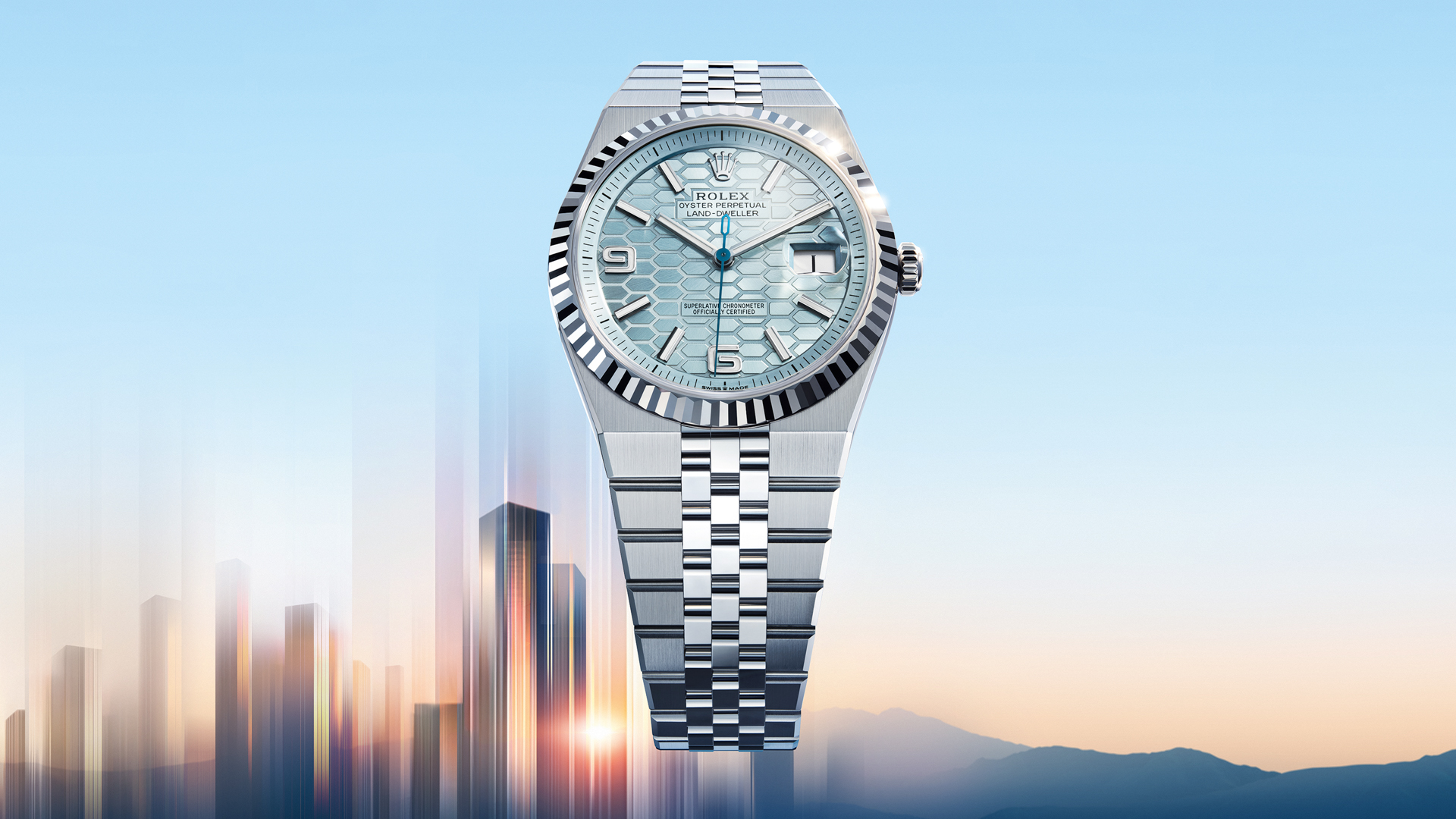 Blue watches are making a comeback, but not in the shade you might think
Blue watches are making a comeback, but not in the shade you might thinkBlue dials are my favourite watch trend of 2025 – here’s why
By Bethan Girdler-Maslen
-
 Girard-Perregaux Laureato 38 mm gets a blue diamond upgrade
Girard-Perregaux Laureato 38 mm gets a blue diamond upgradeWe’re totally besotted by these diamond-bezelled beauties from Girard-Perregaux
By Alistair Charlton
-
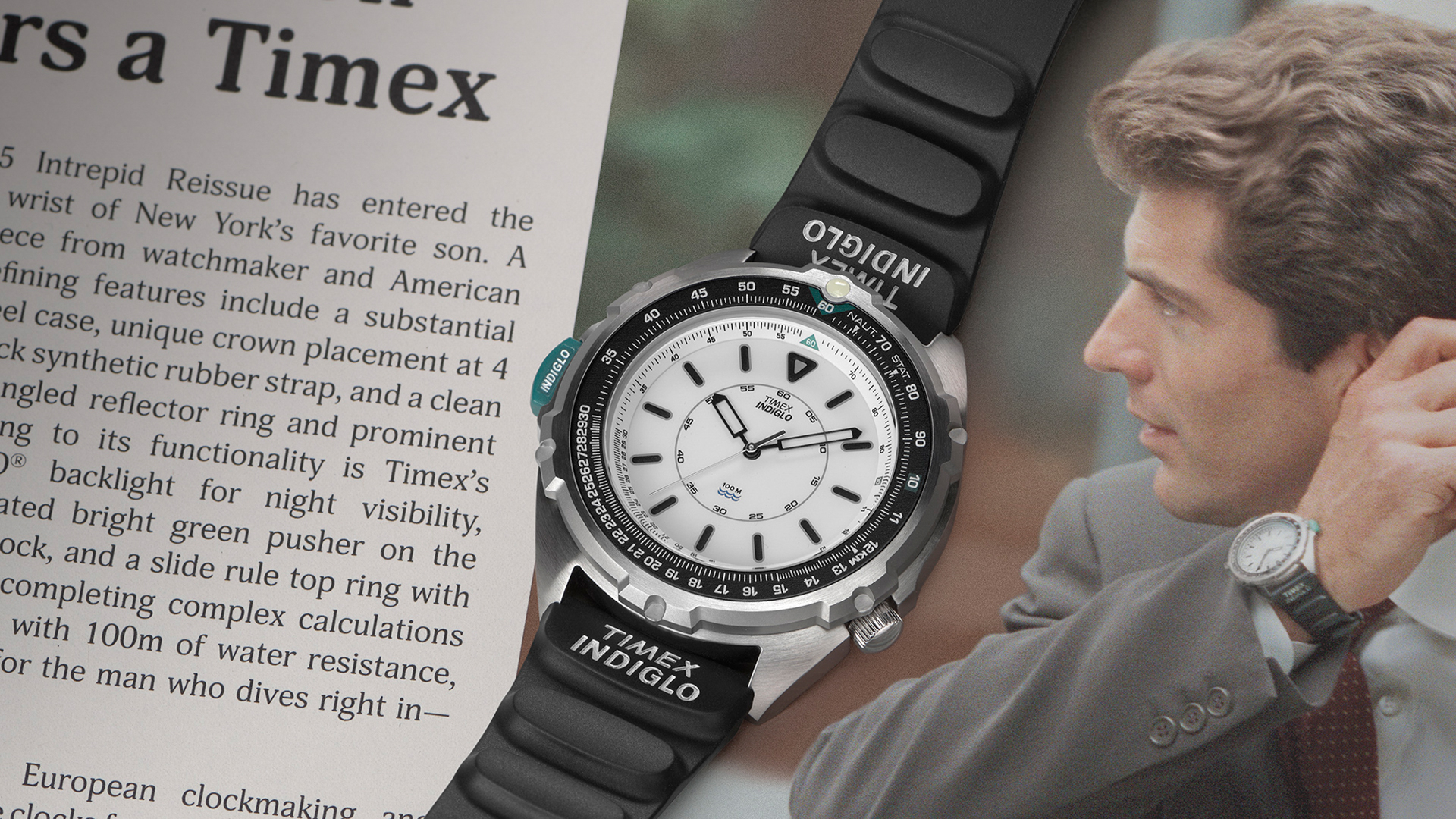 Party like it’s 1995 with this iconic reissue from Timex
Party like it’s 1995 with this iconic reissue from TimexA sailing watch favoured by JFK Jr. is back on the scene
By Alistair Charlton
-
 T3's Best of Watches and Wonders 2025 Awards
T3's Best of Watches and Wonders 2025 AwardsHere are the winners from Watches and Wonders 2025 Awards, as chosen by T3's watch experts
By Sam Cross
-
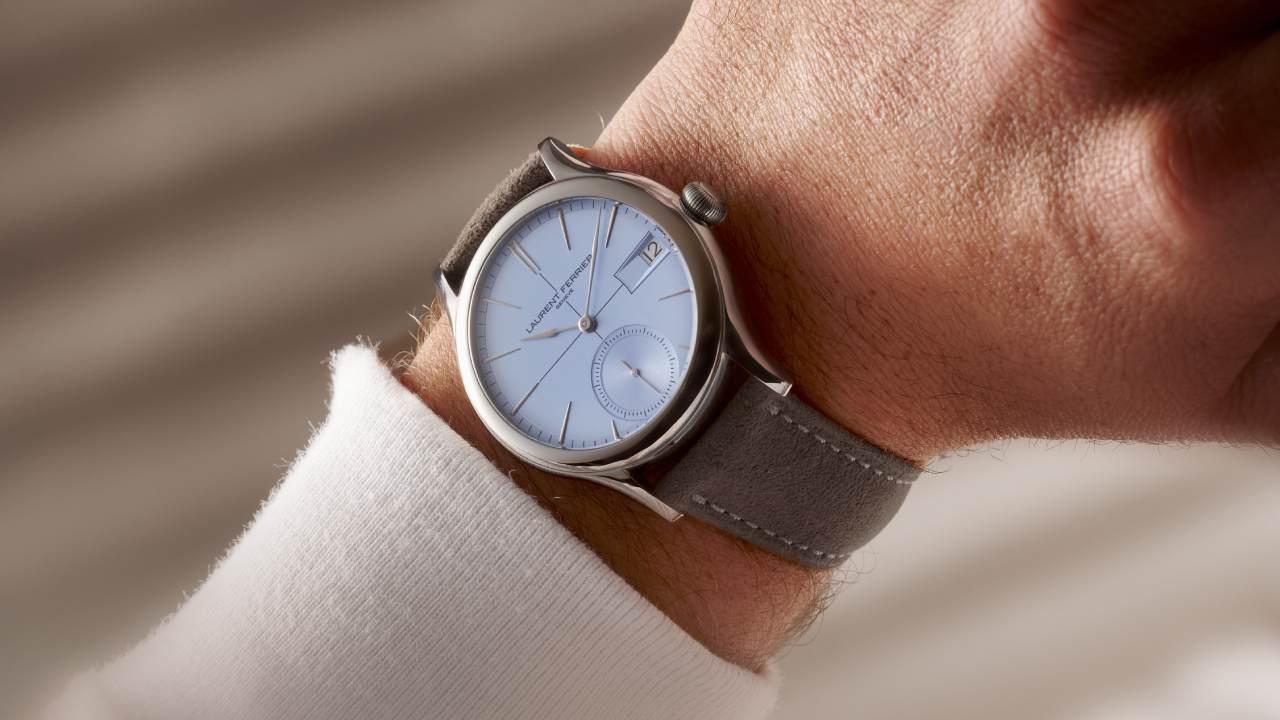 Laurent Ferrier upgrades its Classic Auto watch with stunning blue dial
Laurent Ferrier upgrades its Classic Auto watch with stunning blue dialLaurent Ferrier’s latest novelty might be my favourite from Watches and Wonders
By Bethan Girdler-Maslen
-
 Piaget goes for gold with new Polo 79 and Sixtie novelties at Watches and Wonders
Piaget goes for gold with new Polo 79 and Sixtie novelties at Watches and WondersPiaget has a theme for Watches and Wonders 2025 – gold!
By Bethan Girdler-Maslen
-
 This Grand Seiko is one of the most accurate watches we've ever seen
This Grand Seiko is one of the most accurate watches we've ever seenGrand Seiko’s new watch is accurate to an astonishing ±20 seconds per year
By Alistair Charlton
-
![Ulysse Nardin Diver [Air]](https://cdn.mos.cms.futurecdn.net/nVs6TDSsKaQ8vcLzvgEqQK.jpg) Ulysse Nardin debuts the lightest mechanical dive watch ever made
Ulysse Nardin debuts the lightest mechanical dive watch ever madeWatches and Wonders sees Ulysse Nardin mark a pretty big milestone
By Bethan Girdler-Maslen

